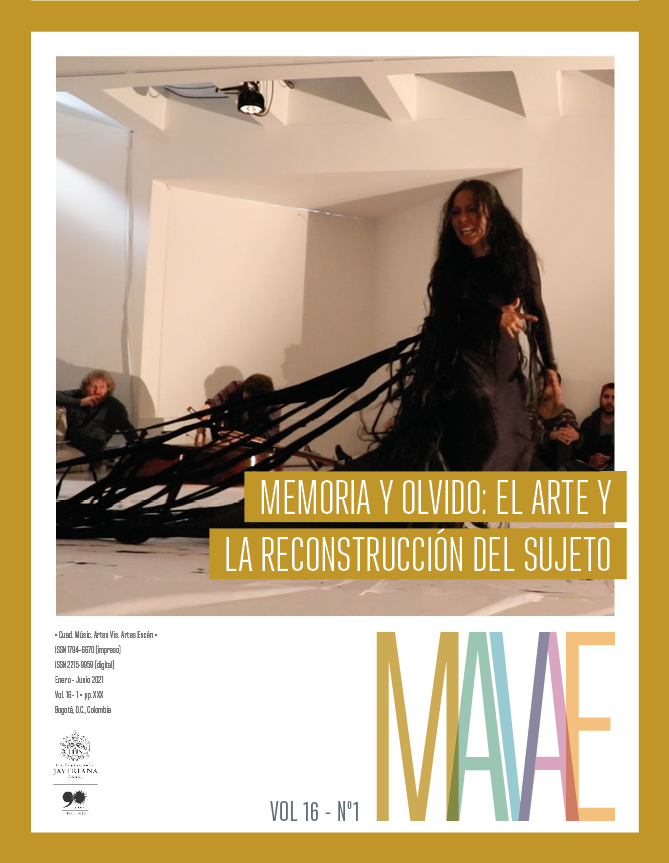Abstract
This work presents the results of the research Images of the Extraordinary: American Monsters of the 16th Century, artistic creation process developed by the students of the Research Seedbed in Visual Arts (SINAV, for its initials in Spanish) of the Visual Arts program of Universidad Nacional Abierta y a Distancia (UNAD) between 2018 and 2019. With the objective of analyzing, in a critical and historical way, the construction of identities on Latin American matters, the representation of the monstrous in the stories and images constructed by the chroniclers of the Indies in the 16th century was used as a framework of analysis. These chroniclers marked processes of cultural marginalization, construction of subjectivities and power dynamics, and presented the American inhabitant as an otherness that was outside the limits of the dominant Western culture. The theoretical postulates about the monstrous are presented as a framework for historical analysis and the creation of works, with a collaborative and largely virtual working methodology. Some results of the historical research are then presented, which gives way to detailing the process of creating work that culminated in the exhibition of the audiovisual installation Images of the Extraordinary, as well as a wide range of contemporary illustrations on the monstrous and a digital product in web page format where a cartography of the monstrous in Latin America is presented and the memories of the whole project are collected.
Bartra, Roger. 1992. El salvaje en el espejo. México: Era.
Botello Gill, Slenka Leandra. 2020. “El SINAV en Colombia: Una experiencia de formación en investigación-creación desde la modalidad de enseñanza virtual”. Revista de Arte Ibero Nierika 18 (9): 13-44. Consultado: 3 de noviembre de 2020. https://nierika.ibero.mx/index.php/nierika/article/view/21.
Chicangana Bayona, Yobeng Aucardo. 2013. Imágenes de caníbales y salvajes del Nuevo Mundo: De lo maravilloso medieval a lo exótico colonial, siglos XV-XVII. Bogotá: Universidad del Rosario.
Cohen, Jeffrey Jerome. 1996. Monster Theory: Reading Culture. Minnesota: University of Minnesota Press.
Courtine, Jean-Jacques. 2005. “El espejo del alma”. En Historia del cuerpo. Vol. 1: Del Renacimiento a la Ilustración, dirigido por Alain Corbin, Jean Jacques Courtine y Georges Vigarello. Madrid: Taurus.
D’Anghiera, Pietro Martire. 2012. Décadas del Nuevo Mundo. Buenos Aires: Maxtor.
De las Casas, fray Bartolomé. 1892. “Relación del primer viaje del descubrimiento”. En Relaciones y cartas de Cristóbal Colón, 1-183. Madrid: Biblioteca Nacional. Consultado: 3 de noviembre de 2020. http://www.cervantesvirtual.com/obra-visor/relaciones-y-cartas-decristobal-colon--0/html/.
De Zárate, Agustín. 1995. Historia del descubrimiento y conquista del Perú, 1555. Lima: Pontificia Universidad Católica del Perú.
Flores, María Alejandra. 2013. “Las Amazonas en el Nuevo Mundo: Un mito por conquistar”. Ubi sunt? Revista de Historia 28: 39-47.
Hall, Stuart. 2000. “Who Needs ‘Identity’?” En Identity: A Reader, 15-30. Londres: Sage.
Pantoja, Richard. 2018. Hombres cola de lagarto: Propuesta gráfica para imágenes de lo extraordinario. Bogotá: Universidad Nacional Abierta y a Distancia.
Raleigh, sir Walter. 2013. The Discovery of the Guiana. The Gutenberg Project. Consultado: 3 de noviembre de 2020. ttps://www.gutenberg.org/files/2272/2272-h/2272-h.htm
Rojas-Mix, Miguel. 1992. América imaginaria. Barcelona: Lumen.
Toledo Castellanos, Ricardo. 2018. Abrir mundo: Resistencia, visualidad y producción artística. Bogotá: Universidad Nacional Abierta y a Distancia. Consultado: 3 de noviembre de 2020. https://hemeroteca.unad.edu.co/index.php/book/article/view/3308/3297.
Vignolo, Paolo. 2003. “Nuevo Mundo: ¿Un mundo al revés? Las antípodas en el imaginario del Renacimiento”. En El Nuevo Mundo: Problemas y debates, editado por Diana Bonnett y Felipe Castañeda Salamanca, 23-60. Bogotá: Universidad de los Andes.

This work is licensed under a Creative Commons Attribution 4.0 International License.
Copyright (c) 2021 Slenka Leandra Botello Gil y Daianna Sierra Camacho


